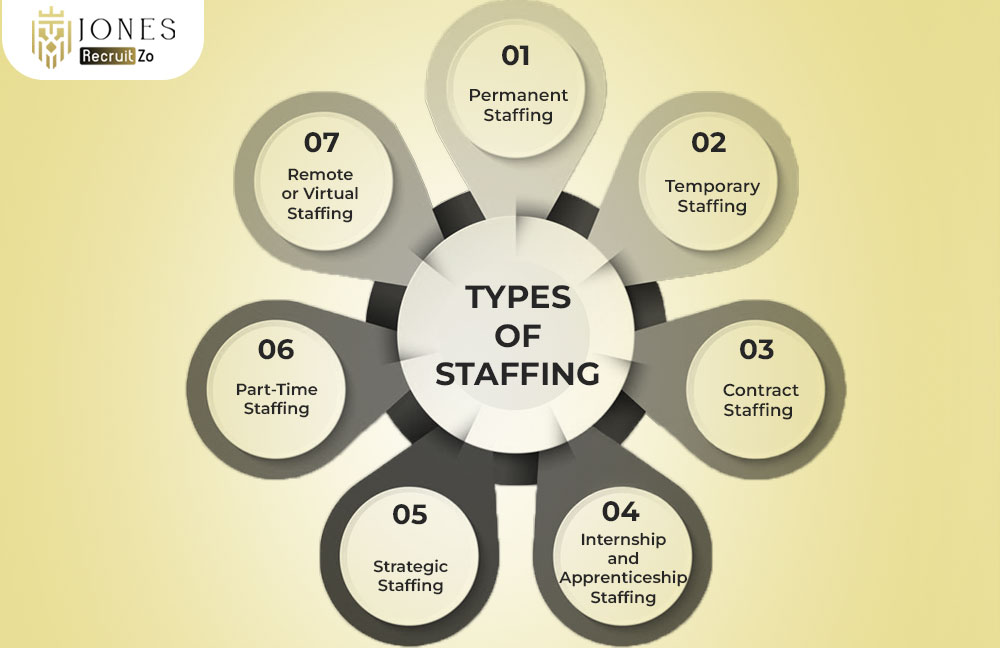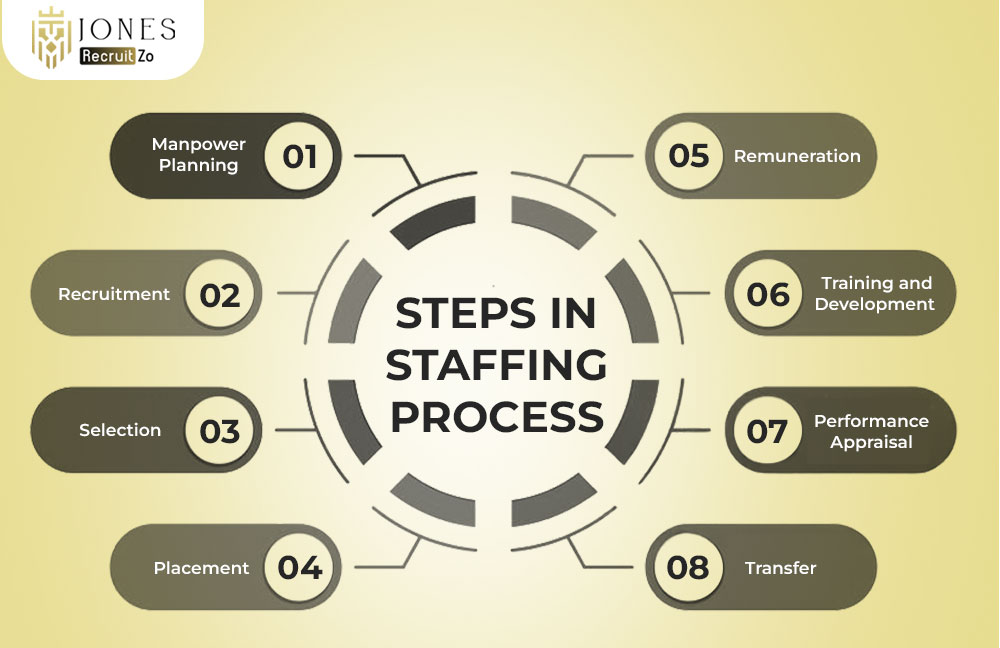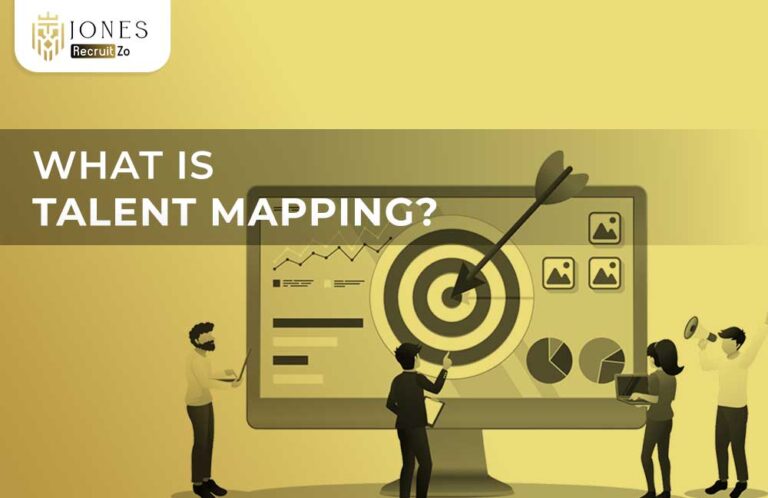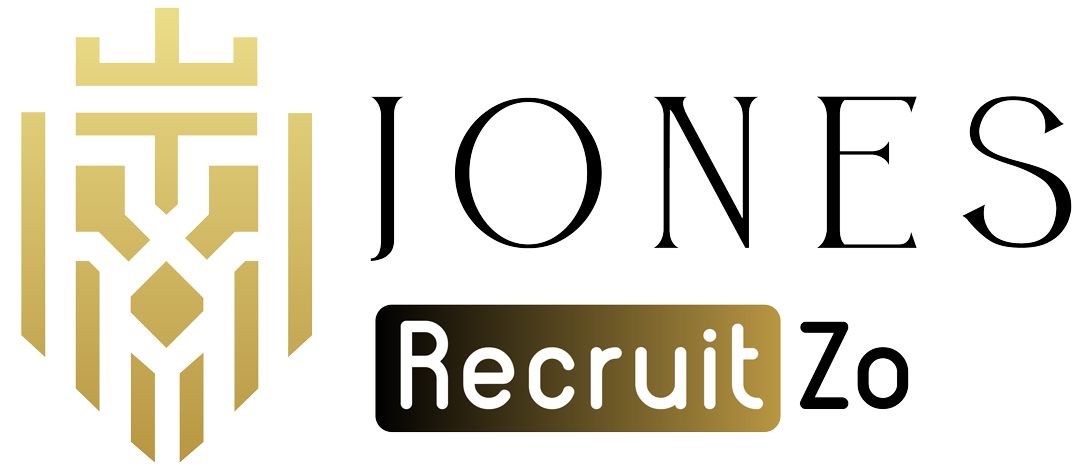What is Staffing?
Staffing can be defined as the process of acquiring, developing and retaining people to give an organization the appropriate talent. It deals with recruitment, developing and matching employees to the job position in order to achieve business objectives. Understanding what is staffing as a key function of HR enables the organization to get the right people, at the right position and to develop them further to achieve organizational goals effectively.
Types of Staffing

Staffing types can be classified as permanent, temporary, contract, internship, strategic, part-time and remote staffing. Each has its own purposes for supporting the workforce, and they can be flexible, specialized in skills, or provide long-term stability depending on the organizational objectives.
Permanent Staffing
Permanent staffing is recruiting workers on a long-term basis with accompanying benefits such as medical cover and retirement packages. This form of staffing creates loyal employees and strengthens culture in the organization due to long term employment stability and growth provision in the job.
Temporary Staffing
Temporary staffing is a versatile model where organizations recruit individuals on a short-term basis or in building a particular project. It’s perfect when the business is at the peak or when employees are absent and the firms can adapt quickly. It is one of the alternatives applied in seasonal demand.
Contract Staffing
Contract staffing supplies skilled individuals on assignment basis and over specified periods of time. This approach is suitable to projects that need expertise but do not want to raise long-term payroll. It helps in cost-effectiveness and unrestricted staffing management as compared to the other varieties of staffing.
Internship and Apprenticeship Staffing
The internship and apprenticeship staffing are temporary in nature and are a combination of both learning and job experience. Internships provide short term exposure, whereas, apprenticeships are formally organized skill based programs. Such a staffing process is advantageous to students and organizations that require future-ready talent.
Strategic Staffing
Strategic staffing is an information based, future focused staffing procedure which links staffing with organizational requirements. It entails workforce, talent planning and development. This model will assure that the appropriate individuals are put in position where long term success and sustainability lies.
Part-Time Staffing
Part-time staffing refers to employment of workers who work fewer hours as compared to full-time employees. It is flexible to business and workers. Compared to the varieties, it can be used to address workload fluctuations whilst keeping the expenses in check and provide work-life balance.
Remote or Virtual Staffing
Remote or virtual staffing is the ability of employees to work at home or in distant places through the use of digital resources. This staffing flexibility increases access to talent around the globe, lowers overhead expenses, and helps business resilience in the case of disruptions, such as pandemics.
Benefits of Staffing

The main advantages of staffing are enhanced productivity, increased employee retention, accelerated recruitment process, and flexibility of the workforce. It makes sure that the right people occupy positions and this promotes organizational development, cost-effectiveness, and sustainability.
Right Person for the Right Job
Proper staffing helps in putting the right people in the right job, which improves morale and productivity. This specific practice reduces burnout, and it also matches talents with the work. It improves the harmony of the organization and boosts competitive edge in the contemporary dynamic employment environment.
Improved Productivity
Productivity is enhanced through strategic staffing by matching the skills with the job. It entails a selective recruitment, development, and designing of teams to smooth out the procedures. When placed properly, performance is boosted and it leads to overall growth and efficiency in the organization.
Better Employee Retention
Staffing increases retention through role-fit, potential recognition, and growth. When employees are satisfied they will not run away and this saves on recruiting employees time and again. High retention helps maintain a consistent culture and saves the expenses onboarding and training.
Scalability and Flexibility
An effective staffing process can provide elasticity in the level of staffing. It enables companies to be flexible according to the changes in demand. Companies deal with seasonal curves, emergencies or rapid growth in a cost-effective way by applying the various forms of staffing.
Faster Hiring Process
An efficient staffing process lowers time-to-hire and candidates experience. Use of staffing firms or internal systems helps speed up the process of screening, selection and on boarding. The result is a quicker time in hiring staff and having an advantage of acquiring the best employees.
Steps in Staffing Process

The staffing process entails planning, recruitment, selection, placement, remuneration, training, performance appraisal, and transfers. These measures assist in creating an effective workforce that is laced with the company objectives and employee growth.
Manpower Planning
The initial stage in the staffing process is manpower planning. It involves examination of existing workforce, future projections, skill gaps and the development of strategies to close the gaps. It establishes the basis of good staffing choices and expansion of an organization.
Recruitment
Recruitment is an important process which entails advertising the positions to the appropriate individuals by use of job advertisements, referral or employment agencies. The resumes are sifted through on qualification. This is where what is staffing comes into play as a methodical attempt to align talent with work positions.
Selection
Selection comes after recruitment and this entails evaluating the candidates based on interviews, testing and assessment. The individuals who most closely fit roles are offered the positions. This is a step of making sure that only competent people continue with the staffing process which minimises turnover.
Placement
Staffing placement is the act of matching successfully recruit candidates with appropriate job positions. It also makes sure that the skills are optimally utilized, as well as promoting job satisfaction. This step plays a pivotal role in maximising both individual and organizational performance and minimising mismatches.
Remuneration
Remuneration is a crucial component of the staffing process which entails provision of enough compensation in terms of salary and welfare. The decisions are arrived at based on the market rates and complexity of the job. Proper compensation will aid retention and show the worth of each position that is occupied.
Training and Development
Training and development refers to the enhancement of the capability of employees so that they perform their jobs better. This is a staffing process that develops future leaders, minimises skill gaps, and maximises overall effectiveness in the workplace due to the structured learning and mentorship.
Performance Appraisal
Performance appraisal compares the output of the employee with the standards. This step in staffing process involves taking of measurement, comparison and discussion of outcomes to establish what is good and what needs to be worked on. Appraisals facilitate the keeping of performance in line with organizational expectations and future ambitions.
Transfer
Transfer involves a move within the location or department but not the pay and rank. It entails need recognition, candidate selection and moving. Transfers assist in career development, equalise manpower, and maintain operations smooth within departments.
FAQs
1) What is Staffing in management?
Staffing can be defined as the process of acquiring, developing and retaining people to give an organization the appropriate talent. It deals with recruitment, developing and matching employees to the job position in order to achieve business objectives.
2) What are the types of staffing?
Staffing types can be classified as permanent, temporary, contract, internship, strategic, part-time and remote staffing. Each has its own purposes for supporting the workforce, and they can be flexible, specialized in skills, or provide long-term stability depending on the organizational objectives.
3) What is the role and purpose of staffing?
Staffing’s role and purpose is to ascertain that the right people are recruited, trained and positioned in right jobs. Effective talent management aids it to support organizational efficiency, workforce needs, and business development.
4) What are the 7 steps of the staffing process?
The staffing process entails planning, recruitment, selection, placement, remuneration, training, performance appraisal, and transfers. These measures assist in creating an effective workforce that is laced with the company objectives and employee growth.













